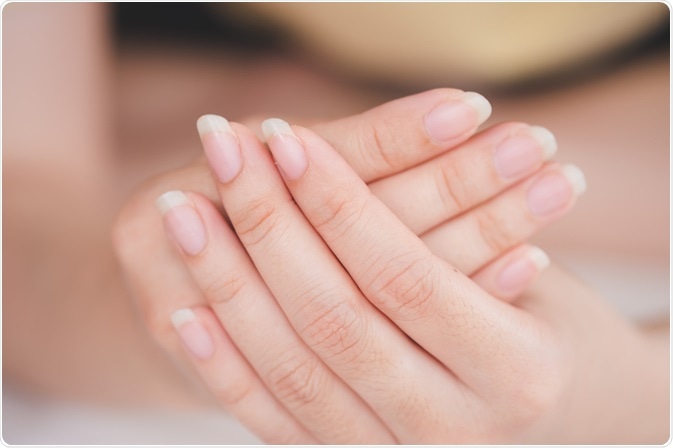Sponsored Content by Glas-ColNov 23 2018
Although common, fungal toenail or fingernail infections are extremely uncomfortable conditions. As a result of the wide range of factors influencing the health of our nails, it can also be hard to diagnose these infections with complete certainty.

Image Credit: Shutterstock/Maliwan Prangpan
The two key indicators of a fungal hyphae are nail deformation and discoloration, both of which can be caused by poor nutrition, bacterial infections, or as the side effects of medication. Generally, a nail clipping must be homogenized, cultured, and microscopically observed to see if fungal cells are present, in order to obtain an accurate diagnosis of a fungal nail infection.
Keratin is a crucial structural protein that assembles as a broad range of epidermal appendages in mammals, reptiles, birds and amphibians. It forms the main constituent of tough biological tissue, including human nails and hair. Due to keratinized tissue’s resilience, it can be extremely difficult to homogenize the tissue using conventional mixing products.
The most widely used method of preparing samples for dermatological cell culturing is the grinding of nail specimens in handheld attrition mills. It exceeds alternative mixing products in terms of its application specificity on several fronts. The uses of attrition mill mixing products for nail homogenization are explored in greater detail in this article.
Dermatological Mixing Products
A specialized mixing product for dermatological testing applications called the ‘Nail Homogenizer’ has been developed by Glas-Col. It is made of two separate stainless-steel holders which have internal grinding surfaces. These holders are fitted together in order to form a mill cavity.
Weighing only 2 lbs, the homogenizer supports the handheld grinding of sample tissue, and provides a novel solution to the bottleneck of alternative sample preparation methods. Additionally, it offers finely-tuned homogenization for distinct cell culture methodologies, as it features an adjustable clearance between cutting heads.
Aside from a dedicated Nail Homogenizer, there are very few mixing products which can micronize keratinized tissue so well. When the attrition mill homogenizes nail samples, the samples interact with 10% aqueous solutions of potassium hydroxide (KOH) more readily. This improves the study’s accuracy and speed, as well as enhancing the chances of discovering fungal hyphae in a sample.
The number of cell particles derived from a sample is pivotal to the success of cell isolation for dermatological testing. The particle count from sample pulverization is maximized by mixing products like the Nail Homogenizer, which breaks down keratin and the layers of dead cells accumulating around a nail. This increases the chances that a viable fungal cell will contact the medium of the cell culture.
Mixing Products from Glas-Col
Glas-Col is a global leader in the supply of mixing products and laboratory instrumentation for a variety of medical and analytical applications.
About Glas-Col
Glas-Col is the world's leading manufacturer of laboratory products and industrial heating and mixing technology. The combination of modern facilities, and highly trained personnel, keep Glas-Col on the leading edge of technology for pharmaceutical, biotechnology, semiconductor, industrial, and the research & development industry.
Ongoing product development, using state-of-the-art manufacturing concepts and materials, is one of the key ingredients to Glas-Col's continued success in meeting our client's application requirements.
With over 70 years of experience Glas-Col is also capable of meeting the needs of researchers and scientists. Our laboratory equipment and industrial products are backed by our excellent service, support and technical know how. Glas-Col is an ISO certified company and has maintained this certification for fourteen straight years. Our goal is to provide quality laboratory equipment, safety accessories and industrial products which will provide you, the customer, repeatable, reliable, results.
Sponsored Content Policy: News-Medical.net publishes articles and related content that may be derived from sources where we have existing commercial relationships, provided such content adds value to the core editorial ethos of News-Medical.Net which is to educate and inform site visitors interested in medical research, science, medical devices and treatments.